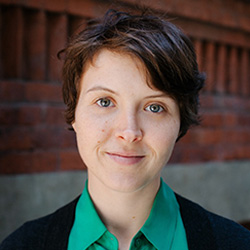
All throughout the summer, we’ll be profiling members across the 18F team. Nicole Fenton joined 18F in September of 2015. Before 18F, Nicole was a content strategist at Facebook, Lab Zero, and Mule Design in San Francisco. She started her professional writing practice at Apple, where she served as communications lead for five years and helped launch the original iPhone and iPad.
Melody Kramer: Tell me about your path to 18F.
Nicole Fenton: I studied English in college and I knew I wanted to write professionally, but I wasn’t interested in advertising or journalism. So I was thinking, “What do I do with my degree?”
I decided to apply to work at a company I respected, and at the time it was Apple. But Apple doesn’t hire people like me for writing jobs right out of college. So I applied to work in the call center. I answered the phone and worked as an email support rep for a few months, and then moved into developing training, documentation, and help content. I eventually worked my way up to leading a team of writers who supported the online store.
I was there for five years and worked on communications for product launches and a global checkout redesign, so I learned how to manage the content translation process, and write for different regions and languages. I worked with all sorts of people across the organization — sales, support, logistics, legal, and the technology teams who supported the call center. It was a very cross-functional role.
I was lucky enough to work there when the original iPhone/iPad were launched too. In doing that work, I realized I wanted to take a broader approach to writing for the web. It was right around the time content strategy was officially becoming a thing, and I very much wanted to focus on that full time alongside designers.
Since then, I’ve been doing full-time content strategy work. I started writing and talking about it more publicly. I freelanced and worked for two client services agencies in San Francisco: Mule Design and Lab Zero. I learned a lot working alongside designers and engineers, and I started thinking about the ideal process for content work. I started wishing I could collaborate with other content people—it’s rare to find a team of writers and strategists collaborating on a larger product experience. So I went to work at Facebook for a while.
That was really fun and challenging work, but I wanted to do more to help people directly. I loved the people there and the level of scale and impact — we could test things with very specific audiences and learn a lot really fast. That helped me come up with a framework for content testing and structured text. But it left me wanting more on a personal level, so I decided to leave and cowrite a book, and then I spent a couple of years consulting and speaking at conferences. And now, after reflecting on my own needs and interests, here I am at 18F.
MK: How did you find out about 18F?
NF: I first heard about 18F through Jesse Taggert. We were friends in San Francisco before I moved to New York. We always keep an eye on what the other person is doing.
I would occasionally read the blog, and I also know Meghana from my work at the School for Visual Arts, so I was curious about the team.
As a strategist, I do a lot of thinking about goals and next steps, and I realized I wanted to work in government. My skillset — writing in plain language and designing forms and flows — is useful in this context. I mean, who has more forms than the government? I love helping people, and I’m not interested in only helping a particular demographic. Our government is here to serve the people, and I believe that means everyone.
I was also excited by the distributed nature of 18F. We’re a distributed team, and we try to be as open and transparent as we can. We write collaboratively and share our work with the public. All of those things are appealing to a wordsmith like me.
MK: What have you worked on so far?
NF: At 18F, I’ve worked with the United States Extractives Industry Transparency Initiative (USEITI) where I helped the U.S. Department of the Interior present complicated information about how public land gets used for natural resource development, and how the government distributes money from those leases. I also served a three-month rotation as 18F’s onboarding lead, and worked on a research project about digital transformation in government.
MK: What was most surprising to you about joining 18F and the federal government?
NF: Most of the time, it doesn’t feel like I’m working in government. Coming from the private sector and higher education, I expected my process to need to change a lot to support policies or existing structures.
Other than new hire paperwork, mandatory trainings, and needing to understand how the government works, my process of writing and editing and managing content projects is pretty much the same.
MK: What do you hope to take with you?
I don’t know if I can answer that yet. I am thinking through that now — what do I want to learn in my remaining time here, and what should I do next?
One thing I do know is that relationships are important, especially in government. The government is huge and I’m still new here, so I don’t know that many people. I’m trying to build strong relationships and understand what other people are working on so I can support those efforts or, at the very least, learn from their experiences.

